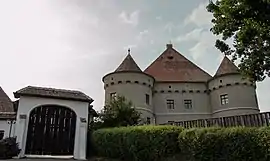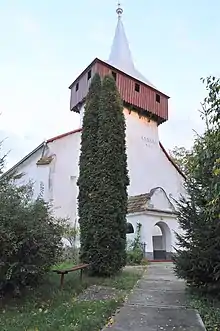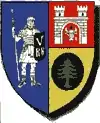Cetatea de Baltă
Cetatea de Baltă (Hungarian: Küküllővár; German: Kokelburg) is a commune in Alba County, Transylvania, Romania. The commune is composed of four villages: Cetatea de Baltă, Crăciunelu de Sus (Christendorf; Felsőkarácsonyfalva), Sântămărie (Frauenkirch; Boldogfalva), and Tătârlaua (Taterloch; Felsőtatárlaka).
Cetatea de Baltă | |
|---|---|
 Bethlen-Haller Castle | |
 Location in Alba County | |
 Cetatea de Baltă Location in Romania | |
| Coordinates: 46°15′N 24°10′E | |
| Country | Romania |
| County | Alba |
| Government | |
| • Mayor (2020–2024) | Constantin Comandaru (PNL) |
| Area | 64.91 km2 (25.06 sq mi) |
| Elevation | 267 m (876 ft) |
| Population (2021-12-01)[1] | 2,792 |
| • Density | 43/km2 (110/sq mi) |
| Time zone | EET/EEST (UTC+2/+3) |
| Postal code | 517235 |
| Vehicle reg. | AB |
| Website | cetateadebalta |
Geography
The commune is located in the northeastern corner of the county, on the border with Sibiu and Mureș counties. It is traversed by county road DJ 117, which connects it to Târnăveni, 15 km (9.3 mi) to the northeast, and to Blaj, 21 km (13 mi) to the southeast; the county seat, Alba Iulia, is some 35 km (22 mi) past Blaj.
To the east it borders with Adămuș commune from Mureș County and with Bazna commune from Sibiu County, to the south and west with Valea Lungă commune, and to the west and north with Jidvei commune.
Cetatea de Baltă lies on the left bank of the river Târnava Mică. The river Balta which discharges into the Târnava Mică in the village of Sântămărie. The river Tătârlaua is a left tributary of the river Balta; it discharges into the Balta in the village of Tătârlaua.
Population
| Year | Pop. | ±% |
|---|---|---|
| 1850 | 3,102 | — |
| 1900 | 3,684 | +18.8% |
| 1941 | 4,450 | +20.8% |
| 2002 | 3,217 | −27.7% |
| 2011 | 2,930 | −8.9% |
| 2021 | 2,792 | −4.7% |
| Source: INS, Census data | ||
At the 2021 census, Cetatea de Baltă had a population of 2,792, of whom 41.26% were Romanians, 38.04% Roma, and 14.46% Hungarians. At the 2011 census, the commune had 2,930 inhabitants, of whom 48.4% were Romanians, 33.3% Roma, 17.8% Hungarians, and 0.5% Germans. At the 2002 census, the villages of Cetatea de Baltă and Crăciunelu de Sus had an ethnic majority of Romanians, Săntămărie an ethnic majority of Hungarians, and Tătârlaua an ethnic majority of Roma.
Touristic sights
- The Bethlen Castle, built in the 16th century in the French Renaissance style and restored in the 17th-18th centuries in the Baroque style.
- A fortress (1st century BC-1st century AD), today only ruins.
- The Reformed Church, a 13th-century building.
Economy
The most important economic resource is agriculture. Cetatea de Baltă is part of the Târnave Vineyard, making viticulture an essential component of the local economy.
References

_retusat_2016.jpg.webp)
